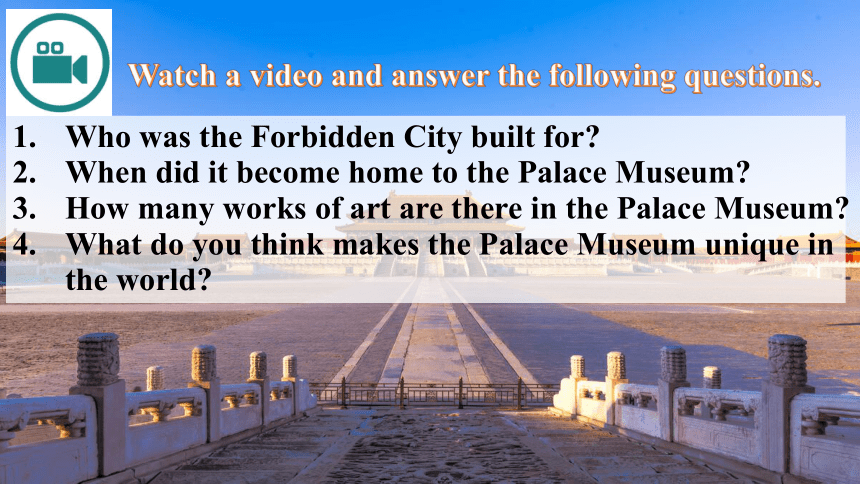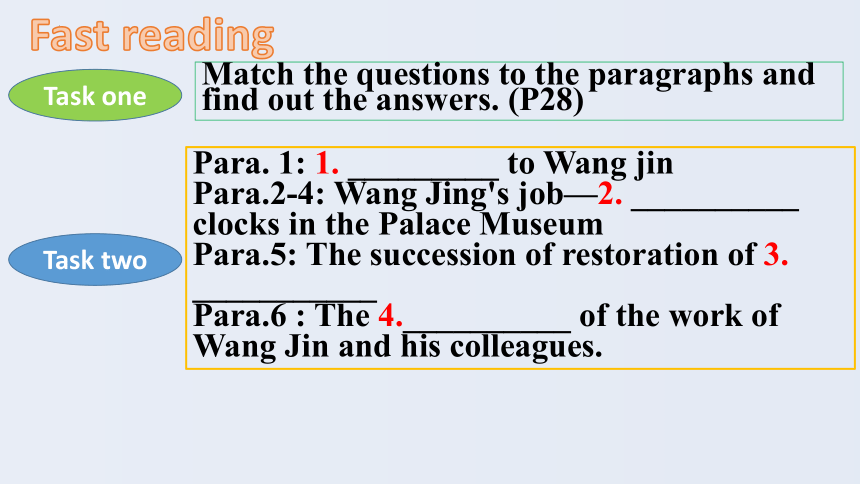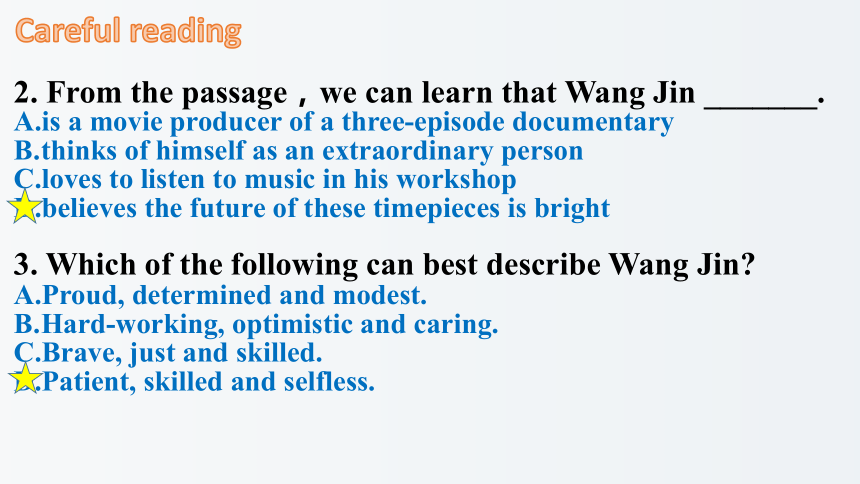外研版高中英语选修三Unit 2 A life`s work Developing ideas Masters语言点课件(共55张PPT)
文档属性
| 名称 | 外研版高中英语选修三Unit 2 A life`s work Developing ideas Masters语言点课件(共55张PPT) |  | |
| 格式 | pptx | ||
| 文件大小 | 26.2MB | ||
| 资源类型 | 教案 | ||
| 版本资源 | 外研版(2019) | ||
| 科目 | 英语 | ||
| 更新时间 | 2024-03-18 18:36:31 | ||
图片预览












文档简介
(共55张PPT)
新外研社高中英语选择性必修三Unit2 A Life’s Work
Developing Ideas
Reading
Have you ever visited the following famous places in Beijing
the Great Hall of the People
the Summer Palace
Temple of Heaven
the Forbidden City
Tian'anmen (square)
the Ming Tombs
Who was the Forbidden City built for
When did it become home to the Palace Museum
How many works of art are there in the Palace Museum
What do you think makes the Palace Museum unique in the world
Watch a video and answer the following questions.
The Forbidden City
Who was the Forbidden City built for
When did it become home to the Palace Museum
How many works of art are there in the Palace Museum
What do you think makes the Palace Museum unique in the world
Emperors, their families and servants in the Ming and Qing dynasties.
It became home to the Palace Museum in 1925.
There are around 1.8 million works of art.
Its history and works of art.
1. What is your understanding of the title, “Masters of Time”
2. What figure of speech does the author use
The title shows us that those mentioned
in the text are all experts skilled at the
art of clock repairing.
Metaphor.
Fast reading
Task one
Match the questions to the paragraphs and find out the answers. (P28)
Task two
Para. 1: 1. _________ to Wang jin
Para.2-4: Wang Jing's job—2. __________ clocks in the Palace Museum
Para.5: The succession of restoration of 3. ___________
Para.6 : The 4.__________ of the work of Wang Jin and his colleagues.
a. Why is Wang Jin optimistic about the future of the timepieces in the Palace Museum
b. Why is it painstaking for Wang Jin and his students to repair the collection of timepieces in the Palace Museum
c. What has been done to the clocks that date back to the time of Emperor Qianlong
d. Who is Wang Jin and where does he work
e. What qualities do Wang Jin and his colleagues display in their work
f. What was special about Wang Jin and his student Qi Haonan
Para.1
Para.2
Para.3
Para.4
Para.5
Para.6
Task one
Para. 1: 1. ______________ to Wang jin
Para.2-4: Wang Jing's job—2. __________ clocks in the
Palace Museum
Para.5: The succession(继承人) of restoration of 3. _________
Para.6 : The 4.___________ of the work of Wang Jin and his colleagues.
Task two
Introduction
restoring
clocks
significance
Careful reading
1. In which section of a newspaper may this text appear
Entertainment
Health
Education
Figure
Careful reading
2. From the passage,we can learn that Wang Jin _______.
is a movie producer of a three-episode documentary
thinks of himself as an extraordinary person
loves to listen to music in his workshop
believes the future of these timepieces is bright
3. Which of the following can best describe Wang Jin
Proud, determined and modest.
Hard-working, optimistic and caring.
Brave, just and skilled.
Patient, skilled and selfless.
4. From the passage,we can learn that Wang Jin _______.
is a movie producer of a three-episode documentary
thinks of himself as an extraordinary person
loves to listen to music in his workshop
believes the future of these timepieces is bright
5. Which of the following can best describe Wang Jin
Proud, determined and modest.
Hard-working, patient and caring.
Brave, just and skilled.
Optimistic, skilled and selfless.
Para.4 …the most beautiful music in the world.
Para.4 ordinary
Para.5 the last two sentence
Para.1
modest√
Hard-working√
skilled√
adj. 公平的;公正的
In the quiet courtyards of Xi San Suo behind the high walls of the Forbidden City, time ticks at its own pace. If it hadn't been for a three-episode documentary, outsiders would never have known that the plainly-dressed people working here are masters of their craft, who have spent their lives restoring precious antiques. Among these is the clock restoration master, Wang Jin.
Walking through the seven crimson gates towards his workplace, Wang Jin still regards himself as an ordinary worker in the Palace Museum, although now he is often stopped by admirers wanting their photo taken with him. Day in, day out, Mr Wang and his students spend their time restoring clocks dating back Hundreds of years. But for quite some time, he and his student Qi Haonan used to be the only two people repairing timepieces in the Palace Museum.
Qing emperors were very fond of clocks. Therefore, in order to please them, foreign envoys presented these emperors with the most intricate and splendid timepieces. Today, the Palace Museum has one of the most significant collections of timepieces in the world, mainly originating from Europe and China. With objects ranging from small pocket watches to clocks over one metre in height, each of these requires its own unique method of restoration. Given the complexity of the work and the lack of necessary materials, this means that each expert can work on a maximum of two large pieces a year. But, through their painstaking efforts, Mr Wang and his students do more than repair the clocks, they bring them back to life.
The only sound to break the silence in Wang Jin's workshop is the chiming melody of the repaired and polished clocks. To Wang Jin, it is the most beautiful music in the world. Now, after eight months of endless adjustments, the time has finally come for Mr Wang to wind up the gigantic clocks that date back to the time of Emperor Qianlong. The intricately fashioned objects that have stood still for centuries instantly come back to life: water flows, boats sail, dogs bark, chickens flap their wings and a woman starts to spin. It is a truly awe-inspiring moment. It is suddenly clear that when the clock masters say that"these antiques have lives", it is neither an exaggeration nor a metaphor.
But, despite the combined work of several generations of masters. it seems unlikely that the restoration of the clocks will ever be complete. Even if every clock in the Palace Museum were restored, there would still be work to do,because restoration would probably need to begin again on the clocks that were repaired long ago. This is a race against time that can never be won! Nonetheless, Mr Wang remains optimistic about the future of these timepieces. Following in the footsteps of his own teacher all those years ago, Mr Wang has now passed on his skills to the new members, who will take on many of the future repairs. What's more, inspired to follow in his father's footsteps, Mr Wang's son now has also taken up repairing antique clocks. This new generation of artisans will not only help preserve traditional skills; the innovation they bring to the craft will also ensure that the art of clock repairing stands the test of time.
In today's fast-paced world, the saying that"time waits for no man' has never seemed more apt. Yet inside the hidden courtyards of Xi San Suo, there is something timeless about the way Mr Wang and his colleagues sedately piece together the past with skilful hands and modest hearts. It is as if they have become one with their craft and with the history of the country.
Post-reading
Work in groups. Give a speech about the spirit of craftsmanship in the Palace Museum.
Post-reading
1. Think about other masters in the Palace Museum. Then discuss the questions within your group to prepare for your speech. Do further research if necessary.
Who are the masters
What fields do they work in
What specific examples can you give of their work
Post-reading
1. Think about other masters in the Palace Museum. Then discuss the questions within your group to prepare for your speech. Do further research if necessary.
What aspects of the spirit of craftsmanship are demonstrated through their work
How can you develop and display such spirit in daily life
Post-reading
2. Organise your speech by completing the table.
Aspects of the spirit of craftsmanship
Supporting examples
Conclusion
Language Points
1. In the quiet courtyards of Xi San Suo, behind the high walls of the Forbidden City, time ticks at its own pace. (Para1. S1)
Xi San Suo 西三所(汉语直接音译),故宫
里的西三所是古时太妃们居住的地方,俗称
寡妇院,现在是文物修复部门的工作场所。
tick:v.滴答作响;给…标记号;运作;空转
n.滴答声;勾号
at its own pace 以自己的节奏
at the pace/at the speed/rate/price/cost/expense of...
此结构短语常与介词“at”搭配
1)The nation's population continues to rise ___a speed of 12 million per year.
2)他获得了名声,牺牲了健康和幸福。
at
His fame was bought at the expense of health and happiness .
2. If it _______________(not be) for a three-episode documentary, outsiders would never have known that the plainly-dressed people working here are masters of their craft, who have spent their lives restoring precious antiques.
three-episode documentary 三集纪录片
本文中的这部纪录片指的是纪录片《我在故宫修文物》
hadn’t been
本句是一个主从复合句。If 引导的是_______条件状语句, 表示与______事实相反,从句谓动用had done,主句用_______________________的形式。
虚拟
would+have done
主句中that引导_______从句,该从句中又包含一个______ 引导的非限制性定语从句,修饰_________.
过去
宾语
who
masters
n. 局外人,外人;这里指“外行人”
Translation
如果不是一部三集的纪录片,外人永远不会知道,在这里工作的那些衣着朴素的人都是技艺精湛的大师,他们一生都在修复珍贵的古董。
3. Day in, day out, Mr Wang and his students spend their time restoring clocks dating back hundreds of years. (Para2 S2)
Day in, day out 日复一日地;夜以继日
=day after day
dating back hundreds of years (可)追溯到几百年前;
date back … (可)追溯到(某个时间点)
Mr Wang王津 clock restoration master 钟表修复大师
restoration【派生词】n. 修复
This custom dates back to the 17th century, but this church dates back 8 centuries.
这种风俗开始于17世纪, 但这个教堂建于8个世纪前。
4. Therefore, in order to please them, foreign envoys presented these emperors
with the most intricate and splendid timepieces.
foreign envoys 外国使节
present
n.
adj.
v.
现在;礼物
出席的;现在的;当前的;存在的
提出;赠送;呈现;授予
presence n.出席;存在;到场
(反) absence
presentation n.介绍;陈述;赠送物;报告
n.
1. We shall be very glad to have your _________ (present).
2. The children were thrilled to bits by their _______ (present).
3. I was asked to give a _____________(present) about my vacation plan in English by my teacher.
presence
presents
presentation
adj. 错综复杂的=complex
adj.极好的;辉煌的;壮观的;杰出的
5. Today, the Palace Museum has one of the most significant collections of timepieces in the world, mainly originating from Europe and China. (Para3 S2)
6. With objects ranging from small pocket watches to clocks over one metre in height, each of these requires its own unique method of restoration.
词族:origin(起源,源头), original, originate (v.), originatorn.创始人;发起人
range n.一系列;范围,界限,区间;山脉;射程
vi.变动,变化;vi.& vt.徘徊,漫步,四处移动
range from... to... 在…与…之间变化; 包括从…到…之间
range between... and... 在…与…之间变化
本单元 understanding ideas:
Nor was it a wide range of contacts and connections.
originating from Europe and China 作定语,修饰collections
6. Given the complexity of the work and the lack of necessary materials, this means that each expert can work on a maximum of two large pieces a year.
given prep. 考虑到;鉴于此处,相当于_____________
considering
7. Now, after eight months of endless adjustments, the time has finally come for Mr Wang to wind up the gigantic clocks that date back to the time of Emperor Qianlong. (Para4 S3)
wind up ①给钟表等上发条
②结束(讲话、会议等)
③以……告终
④ 关闭(公司、企业等);(完全)停止营业
在八个月无休止的调整工作后,现在时间终于来到了王师傅给这座可以追溯到乾隆年间的巨大时钟上发条的这一刻。
Translation
If we all agree, let's wind up the discussion.
8. It is suddenly clear that when the clock masters say that “these antiques have lives”, it is neither an exaggeration nor a metaphor.(Para4 the last sentence)
此句中,it作_________ , that从句作真正的________, 主语从句又包含一个when引导的___________从句。
形式主语
主语
时间状语
neither an exaggeration nor a metaphor 既不是夸张,也不是比喻
9. This is a race against time that can never be won!(Para5 S3)
这是一场永远无法胜利的与时间的赛跑。
(比喻,表示工作的艰难)
10. Following in the footsteps of his own teacher all those years ago, Mr Wang has now passed on his skills to the new members, who will take on many of the future repairs.
follow in the footsteps of sb. 跟随某人的脚步
take on 决定做;同意负责;承担(责任)
take up 开始从事
11. In today’s fast-paced world, the saying that “time waits for no man” has never seemed more apt.
①合适的;适宜的;恰当的 (近:__________)
suitable/
appropriate
②有……倾向的 (be apt to do sth 有做某事的倾向)
③聪明的;灵巧的
abbr.
公寓(=apartment)
才能;天资(=aptitude)
1) He has a handful of intelligent and apt students. _________
2)She was apt to raise her voice and wave her hands about. _______
3) This article gives an apt description of the situation. _________
①
②
③
The meaning of the saying “time waits for no man” has never seemed more suitable than it does in today’s fast-paced world.
Paraphrase
时不我待;岁月不待人
1. at one’s own pace ______________________
2. regard oneself as ______________________
3. day in, day out ______________________
4. be fond of ______________________
5. originate from ______________________
6. range from ... to ______________________
7. even if __________________
8. neither ... nor __________________
9. remain optimistic about __________________
10. pass on ... to __________________
11. take on __________________
12. take up ______________
按自己的节奏/速度
认为自己是……
日复一日地
喜欢
源于……;来自……
(范围)从……到……
即使;虽然
既不……也不……
对……保持乐观
传给;传递……给……
承担
开始从事
Writing
Pre-writing
What do the Summer Palace, Yuanmingyuan and the Chengde Mountain Resort all have in common These Qing-dynasty architectural marvels, along with many others, were all built by members of the same family — the Lei family.
n. 奇迹
Read the passage and answer the questions.
Pre-writing
For seven generations, the Lei family quietly dominated imperial architecture. Their designs were admirable, varying from grand buildings to public works, such as roads and dams. So incredible was their skill that many of their buildings survived earthquakes and remained standing over hundreds of years.
v. 支配;控制;左右
Read the passage and answer the questions.
The Lei family were also pioneering engineers, who used a grid system to plan their projects in minute detail. They took careful notes and made models of their projects, many of which have survived to this day and are registered as part of UNESCO’s Memory of the World Programme.
Pre-writing
n. 网格
详尽无遗地
In addition to their architectural achievements, the Lei family showed diligence and humility. Each generation conscientiously learnt their craft and undertook ambitious projects, many of which took years to complete. Yet they did not seek fame, and even today, their great works are associated more with the imperial court than with them.
Pre-writing
n. 谦逊
adv. 勤勉认真地
With their remarkable skills, innovation, diligence and humility, the Lei family leave behind their buildings and the legacy that true craftwork is a treasure that can last beyond a lifetime.
Pre-writing
n. 遗产
1. What is the passage about
The passage is about the Lei family, who for seven generations were behind the marvels of imperial architecture.
Pre-writing
2. What qualities of the Lei family are mentioned Find examples in the passage to support your answers.
The qualities mentioned are those of skill, innovation, diligence and humility. This is evident in their buildings surviving for hundreds of years, in their use of a pioneering grid system to plan their projects, in
Pre-writing
2. What qualities of the Lei family are mentioned Find examples in the passage to support your answers.
each generation’s conscientious learning of their craft and undertaking ambitious projects, and in their works being more associated with the imperial court than with them.
Pre-writing
3. What is the conclusion of the passage
Although the names of those who created these remarkable works may not be known by future generations, their spirit of craftsmanship is everlasting.
Pre-writing
What does an expository essay usually include
Pre-writing
Main Body
an expository essay
Beginning
Conclusion
Stating what it aims to explain or analyse
Organising paragraphs with supporting evidence and facts
Reviewing the main theme of the essay
Choose one person who demonstrates the spirit of craftsmanship and complete the notes. Do further research if necessary.
While-writing
Person:____________________________________
Qualities:___________________________________
Examples:__________________________________
Conclusion:_________________________________
Patterns of exposition are as follows.
While-writing
Exemplification (举例)
Process analysis (过程分析)
Cause-effect analysis (因果分析)
Comparison and contrast (对比与类比)
Classification and division (分类与划分)
Definition (下定义)
Think about the language use in an expository essay.
While-writing
1. Tenses: usually the present tense, including the present perfect tense
2. Mood: usually declarative sentences(陈述句)
Think about the language use in an expository essay.
While-writing
3. Phrases: The following phrases can be effectively used in expository essays: for example, for instance, such as, to illustrate(为了说明), in other words, in this instance(在这种情况下), as an example, according to statistics(依据统计数据)...
While-writing
Now write an expository essay.
An expository essay contains a fair and balanced analysis of an event, a situation or an idea. It commonly begins by clearly stating what it aims to explain or analyse. The main body comprises paragraphs with supporting evidence and facts. It concludes by reviewing the main theme of the essay in light of all the evidence that has been presented.
Learning to learn
While-writing
Now write an expository essay.
Please keep in mind the three parts to be included in an expository essay: beginning, main body and conclusion.
Try to use the words and expressions you have learned.
Do further research if necessary.
Post-writing: Evaluation
Questions Your evaluation Evaluator
Does the expository essay include the key points 4 2 0
Is the expository essay organised properly and smoothly 3 2 1 How is the language 12 8 4 2 How is the handwriting 3 1 -1 Paper design 3 1 -1 TOTAL MARK
Post-writing
The vividly coloured, finely shaped figurines of “Clay Figure Zhang” have been seeing a surge in popularity as an authentic and valuable traditional craft.
The nearly 200-year history of “Clay Figure Zhang” began with Zhang Mingshan, who became known for his ability to breathe life and beauty into these painted clay figurines.
n. 小雕像;小塑像
adj. 真正的;真实的
给……注入生命和美丽
n. 急剧上升;激增
Post-writing
Born into a poor family, Zhang Mingshan made
them as a means of earning a living. He often visited markets where he observed people of all walks of life, and went to theatres to observe those performing on stage. Day in, day out, he used tonnes of clay to mould what he saw, and
一种方法/手段
各行各业
日复一日地
v. 塑造
Post-writing: Reference Text
sometimes added decorative items or new features to the figurines. So vivid and lifelike were they that they attracted crowds of spectators to the stand from which he sold them.
n. 观看者
Post-writing: Reference Text
Fortunately, Zhang Mingshan’s craftsmanship has been passed down through his descendents, with these distinctive clay figurines now being crafted by the sixth generation of “Clay Figure Zhang”.
n. 后代
adj. 有特色的
传下来
新外研社高中英语选择性必修三Unit2 A Life’s Work
Developing Ideas
Reading
Have you ever visited the following famous places in Beijing
the Great Hall of the People
the Summer Palace
Temple of Heaven
the Forbidden City
Tian'anmen (square)
the Ming Tombs
Who was the Forbidden City built for
When did it become home to the Palace Museum
How many works of art are there in the Palace Museum
What do you think makes the Palace Museum unique in the world
Watch a video and answer the following questions.
The Forbidden City
Who was the Forbidden City built for
When did it become home to the Palace Museum
How many works of art are there in the Palace Museum
What do you think makes the Palace Museum unique in the world
Emperors, their families and servants in the Ming and Qing dynasties.
It became home to the Palace Museum in 1925.
There are around 1.8 million works of art.
Its history and works of art.
1. What is your understanding of the title, “Masters of Time”
2. What figure of speech does the author use
The title shows us that those mentioned
in the text are all experts skilled at the
art of clock repairing.
Metaphor.
Fast reading
Task one
Match the questions to the paragraphs and find out the answers. (P28)
Task two
Para. 1: 1. _________ to Wang jin
Para.2-4: Wang Jing's job—2. __________ clocks in the Palace Museum
Para.5: The succession of restoration of 3. ___________
Para.6 : The 4.__________ of the work of Wang Jin and his colleagues.
a. Why is Wang Jin optimistic about the future of the timepieces in the Palace Museum
b. Why is it painstaking for Wang Jin and his students to repair the collection of timepieces in the Palace Museum
c. What has been done to the clocks that date back to the time of Emperor Qianlong
d. Who is Wang Jin and where does he work
e. What qualities do Wang Jin and his colleagues display in their work
f. What was special about Wang Jin and his student Qi Haonan
Para.1
Para.2
Para.3
Para.4
Para.5
Para.6
Task one
Para. 1: 1. ______________ to Wang jin
Para.2-4: Wang Jing's job—2. __________ clocks in the
Palace Museum
Para.5: The succession(继承人) of restoration of 3. _________
Para.6 : The 4.___________ of the work of Wang Jin and his colleagues.
Task two
Introduction
restoring
clocks
significance
Careful reading
1. In which section of a newspaper may this text appear
Entertainment
Health
Education
Figure
Careful reading
2. From the passage,we can learn that Wang Jin _______.
is a movie producer of a three-episode documentary
thinks of himself as an extraordinary person
loves to listen to music in his workshop
believes the future of these timepieces is bright
3. Which of the following can best describe Wang Jin
Proud, determined and modest.
Hard-working, optimistic and caring.
Brave, just and skilled.
Patient, skilled and selfless.
4. From the passage,we can learn that Wang Jin _______.
is a movie producer of a three-episode documentary
thinks of himself as an extraordinary person
loves to listen to music in his workshop
believes the future of these timepieces is bright
5. Which of the following can best describe Wang Jin
Proud, determined and modest.
Hard-working, patient and caring.
Brave, just and skilled.
Optimistic, skilled and selfless.
Para.4 …the most beautiful music in the world.
Para.4 ordinary
Para.5 the last two sentence
Para.1
modest√
Hard-working√
skilled√
adj. 公平的;公正的
In the quiet courtyards of Xi San Suo behind the high walls of the Forbidden City, time ticks at its own pace. If it hadn't been for a three-episode documentary, outsiders would never have known that the plainly-dressed people working here are masters of their craft, who have spent their lives restoring precious antiques. Among these is the clock restoration master, Wang Jin.
Walking through the seven crimson gates towards his workplace, Wang Jin still regards himself as an ordinary worker in the Palace Museum, although now he is often stopped by admirers wanting their photo taken with him. Day in, day out, Mr Wang and his students spend their time restoring clocks dating back Hundreds of years. But for quite some time, he and his student Qi Haonan used to be the only two people repairing timepieces in the Palace Museum.
Qing emperors were very fond of clocks. Therefore, in order to please them, foreign envoys presented these emperors with the most intricate and splendid timepieces. Today, the Palace Museum has one of the most significant collections of timepieces in the world, mainly originating from Europe and China. With objects ranging from small pocket watches to clocks over one metre in height, each of these requires its own unique method of restoration. Given the complexity of the work and the lack of necessary materials, this means that each expert can work on a maximum of two large pieces a year. But, through their painstaking efforts, Mr Wang and his students do more than repair the clocks, they bring them back to life.
The only sound to break the silence in Wang Jin's workshop is the chiming melody of the repaired and polished clocks. To Wang Jin, it is the most beautiful music in the world. Now, after eight months of endless adjustments, the time has finally come for Mr Wang to wind up the gigantic clocks that date back to the time of Emperor Qianlong. The intricately fashioned objects that have stood still for centuries instantly come back to life: water flows, boats sail, dogs bark, chickens flap their wings and a woman starts to spin. It is a truly awe-inspiring moment. It is suddenly clear that when the clock masters say that"these antiques have lives", it is neither an exaggeration nor a metaphor.
But, despite the combined work of several generations of masters. it seems unlikely that the restoration of the clocks will ever be complete. Even if every clock in the Palace Museum were restored, there would still be work to do,because restoration would probably need to begin again on the clocks that were repaired long ago. This is a race against time that can never be won! Nonetheless, Mr Wang remains optimistic about the future of these timepieces. Following in the footsteps of his own teacher all those years ago, Mr Wang has now passed on his skills to the new members, who will take on many of the future repairs. What's more, inspired to follow in his father's footsteps, Mr Wang's son now has also taken up repairing antique clocks. This new generation of artisans will not only help preserve traditional skills; the innovation they bring to the craft will also ensure that the art of clock repairing stands the test of time.
In today's fast-paced world, the saying that"time waits for no man' has never seemed more apt. Yet inside the hidden courtyards of Xi San Suo, there is something timeless about the way Mr Wang and his colleagues sedately piece together the past with skilful hands and modest hearts. It is as if they have become one with their craft and with the history of the country.
Post-reading
Work in groups. Give a speech about the spirit of craftsmanship in the Palace Museum.
Post-reading
1. Think about other masters in the Palace Museum. Then discuss the questions within your group to prepare for your speech. Do further research if necessary.
Who are the masters
What fields do they work in
What specific examples can you give of their work
Post-reading
1. Think about other masters in the Palace Museum. Then discuss the questions within your group to prepare for your speech. Do further research if necessary.
What aspects of the spirit of craftsmanship are demonstrated through their work
How can you develop and display such spirit in daily life
Post-reading
2. Organise your speech by completing the table.
Aspects of the spirit of craftsmanship
Supporting examples
Conclusion
Language Points
1. In the quiet courtyards of Xi San Suo, behind the high walls of the Forbidden City, time ticks at its own pace. (Para1. S1)
Xi San Suo 西三所(汉语直接音译),故宫
里的西三所是古时太妃们居住的地方,俗称
寡妇院,现在是文物修复部门的工作场所。
tick:v.滴答作响;给…标记号;运作;空转
n.滴答声;勾号
at its own pace 以自己的节奏
at the pace/at the speed/rate/price/cost/expense of...
此结构短语常与介词“at”搭配
1)The nation's population continues to rise ___a speed of 12 million per year.
2)他获得了名声,牺牲了健康和幸福。
at
His fame was bought at the expense of health and happiness .
2. If it _______________(not be) for a three-episode documentary, outsiders would never have known that the plainly-dressed people working here are masters of their craft, who have spent their lives restoring precious antiques.
three-episode documentary 三集纪录片
本文中的这部纪录片指的是纪录片《我在故宫修文物》
hadn’t been
本句是一个主从复合句。If 引导的是_______条件状语句, 表示与______事实相反,从句谓动用had done,主句用_______________________的形式。
虚拟
would+have done
主句中that引导_______从句,该从句中又包含一个______ 引导的非限制性定语从句,修饰_________.
过去
宾语
who
masters
n. 局外人,外人;这里指“外行人”
Translation
如果不是一部三集的纪录片,外人永远不会知道,在这里工作的那些衣着朴素的人都是技艺精湛的大师,他们一生都在修复珍贵的古董。
3. Day in, day out, Mr Wang and his students spend their time restoring clocks dating back hundreds of years. (Para2 S2)
Day in, day out 日复一日地;夜以继日
=day after day
dating back hundreds of years (可)追溯到几百年前;
date back … (可)追溯到(某个时间点)
Mr Wang王津 clock restoration master 钟表修复大师
restoration【派生词】n. 修复
This custom dates back to the 17th century, but this church dates back 8 centuries.
这种风俗开始于17世纪, 但这个教堂建于8个世纪前。
4. Therefore, in order to please them, foreign envoys presented these emperors
with the most intricate and splendid timepieces.
foreign envoys 外国使节
present
n.
adj.
v.
现在;礼物
出席的;现在的;当前的;存在的
提出;赠送;呈现;授予
presence n.出席;存在;到场
(反) absence
presentation n.介绍;陈述;赠送物;报告
n.
1. We shall be very glad to have your _________ (present).
2. The children were thrilled to bits by their _______ (present).
3. I was asked to give a _____________(present) about my vacation plan in English by my teacher.
presence
presents
presentation
adj. 错综复杂的=complex
adj.极好的;辉煌的;壮观的;杰出的
5. Today, the Palace Museum has one of the most significant collections of timepieces in the world, mainly originating from Europe and China. (Para3 S2)
6. With objects ranging from small pocket watches to clocks over one metre in height, each of these requires its own unique method of restoration.
词族:origin(起源,源头), original, originate (v.), originatorn.创始人;发起人
range n.一系列;范围,界限,区间;山脉;射程
vi.变动,变化;vi.& vt.徘徊,漫步,四处移动
range from... to... 在…与…之间变化; 包括从…到…之间
range between... and... 在…与…之间变化
本单元 understanding ideas:
Nor was it a wide range of contacts and connections.
originating from Europe and China 作定语,修饰collections
6. Given the complexity of the work and the lack of necessary materials, this means that each expert can work on a maximum of two large pieces a year.
given prep. 考虑到;鉴于此处,相当于_____________
considering
7. Now, after eight months of endless adjustments, the time has finally come for Mr Wang to wind up the gigantic clocks that date back to the time of Emperor Qianlong. (Para4 S3)
wind up ①给钟表等上发条
②结束(讲话、会议等)
③以……告终
④ 关闭(公司、企业等);(完全)停止营业
在八个月无休止的调整工作后,现在时间终于来到了王师傅给这座可以追溯到乾隆年间的巨大时钟上发条的这一刻。
Translation
If we all agree, let's wind up the discussion.
8. It is suddenly clear that when the clock masters say that “these antiques have lives”, it is neither an exaggeration nor a metaphor.(Para4 the last sentence)
此句中,it作_________ , that从句作真正的________, 主语从句又包含一个when引导的___________从句。
形式主语
主语
时间状语
neither an exaggeration nor a metaphor 既不是夸张,也不是比喻
9. This is a race against time that can never be won!(Para5 S3)
这是一场永远无法胜利的与时间的赛跑。
(比喻,表示工作的艰难)
10. Following in the footsteps of his own teacher all those years ago, Mr Wang has now passed on his skills to the new members, who will take on many of the future repairs.
follow in the footsteps of sb. 跟随某人的脚步
take on 决定做;同意负责;承担(责任)
take up 开始从事
11. In today’s fast-paced world, the saying that “time waits for no man” has never seemed more apt.
①合适的;适宜的;恰当的 (近:__________)
suitable/
appropriate
②有……倾向的 (be apt to do sth 有做某事的倾向)
③聪明的;灵巧的
abbr.
公寓(=apartment)
才能;天资(=aptitude)
1) He has a handful of intelligent and apt students. _________
2)She was apt to raise her voice and wave her hands about. _______
3) This article gives an apt description of the situation. _________
①
②
③
The meaning of the saying “time waits for no man” has never seemed more suitable than it does in today’s fast-paced world.
Paraphrase
时不我待;岁月不待人
1. at one’s own pace ______________________
2. regard oneself as ______________________
3. day in, day out ______________________
4. be fond of ______________________
5. originate from ______________________
6. range from ... to ______________________
7. even if __________________
8. neither ... nor __________________
9. remain optimistic about __________________
10. pass on ... to __________________
11. take on __________________
12. take up ______________
按自己的节奏/速度
认为自己是……
日复一日地
喜欢
源于……;来自……
(范围)从……到……
即使;虽然
既不……也不……
对……保持乐观
传给;传递……给……
承担
开始从事
Writing
Pre-writing
What do the Summer Palace, Yuanmingyuan and the Chengde Mountain Resort all have in common These Qing-dynasty architectural marvels, along with many others, were all built by members of the same family — the Lei family.
n. 奇迹
Read the passage and answer the questions.
Pre-writing
For seven generations, the Lei family quietly dominated imperial architecture. Their designs were admirable, varying from grand buildings to public works, such as roads and dams. So incredible was their skill that many of their buildings survived earthquakes and remained standing over hundreds of years.
v. 支配;控制;左右
Read the passage and answer the questions.
The Lei family were also pioneering engineers, who used a grid system to plan their projects in minute detail. They took careful notes and made models of their projects, many of which have survived to this day and are registered as part of UNESCO’s Memory of the World Programme.
Pre-writing
n. 网格
详尽无遗地
In addition to their architectural achievements, the Lei family showed diligence and humility. Each generation conscientiously learnt their craft and undertook ambitious projects, many of which took years to complete. Yet they did not seek fame, and even today, their great works are associated more with the imperial court than with them.
Pre-writing
n. 谦逊
adv. 勤勉认真地
With their remarkable skills, innovation, diligence and humility, the Lei family leave behind their buildings and the legacy that true craftwork is a treasure that can last beyond a lifetime.
Pre-writing
n. 遗产
1. What is the passage about
The passage is about the Lei family, who for seven generations were behind the marvels of imperial architecture.
Pre-writing
2. What qualities of the Lei family are mentioned Find examples in the passage to support your answers.
The qualities mentioned are those of skill, innovation, diligence and humility. This is evident in their buildings surviving for hundreds of years, in their use of a pioneering grid system to plan their projects, in
Pre-writing
2. What qualities of the Lei family are mentioned Find examples in the passage to support your answers.
each generation’s conscientious learning of their craft and undertaking ambitious projects, and in their works being more associated with the imperial court than with them.
Pre-writing
3. What is the conclusion of the passage
Although the names of those who created these remarkable works may not be known by future generations, their spirit of craftsmanship is everlasting.
Pre-writing
What does an expository essay usually include
Pre-writing
Main Body
an expository essay
Beginning
Conclusion
Stating what it aims to explain or analyse
Organising paragraphs with supporting evidence and facts
Reviewing the main theme of the essay
Choose one person who demonstrates the spirit of craftsmanship and complete the notes. Do further research if necessary.
While-writing
Person:____________________________________
Qualities:___________________________________
Examples:__________________________________
Conclusion:_________________________________
Patterns of exposition are as follows.
While-writing
Exemplification (举例)
Process analysis (过程分析)
Cause-effect analysis (因果分析)
Comparison and contrast (对比与类比)
Classification and division (分类与划分)
Definition (下定义)
Think about the language use in an expository essay.
While-writing
1. Tenses: usually the present tense, including the present perfect tense
2. Mood: usually declarative sentences(陈述句)
Think about the language use in an expository essay.
While-writing
3. Phrases: The following phrases can be effectively used in expository essays: for example, for instance, such as, to illustrate(为了说明), in other words, in this instance(在这种情况下), as an example, according to statistics(依据统计数据)...
While-writing
Now write an expository essay.
An expository essay contains a fair and balanced analysis of an event, a situation or an idea. It commonly begins by clearly stating what it aims to explain or analyse. The main body comprises paragraphs with supporting evidence and facts. It concludes by reviewing the main theme of the essay in light of all the evidence that has been presented.
Learning to learn
While-writing
Now write an expository essay.
Please keep in mind the three parts to be included in an expository essay: beginning, main body and conclusion.
Try to use the words and expressions you have learned.
Do further research if necessary.
Post-writing: Evaluation
Questions Your evaluation Evaluator
Does the expository essay include the key points 4 2 0
Is the expository essay organised properly and smoothly 3 2 1 How is the language 12 8 4 2 How is the handwriting 3 1 -1 Paper design 3 1 -1 TOTAL MARK
Post-writing
The vividly coloured, finely shaped figurines of “Clay Figure Zhang” have been seeing a surge in popularity as an authentic and valuable traditional craft.
The nearly 200-year history of “Clay Figure Zhang” began with Zhang Mingshan, who became known for his ability to breathe life and beauty into these painted clay figurines.
n. 小雕像;小塑像
adj. 真正的;真实的
给……注入生命和美丽
n. 急剧上升;激增
Post-writing
Born into a poor family, Zhang Mingshan made
them as a means of earning a living. He often visited markets where he observed people of all walks of life, and went to theatres to observe those performing on stage. Day in, day out, he used tonnes of clay to mould what he saw, and
一种方法/手段
各行各业
日复一日地
v. 塑造
Post-writing: Reference Text
sometimes added decorative items or new features to the figurines. So vivid and lifelike were they that they attracted crowds of spectators to the stand from which he sold them.
n. 观看者
Post-writing: Reference Text
Fortunately, Zhang Mingshan’s craftsmanship has been passed down through his descendents, with these distinctive clay figurines now being crafted by the sixth generation of “Clay Figure Zhang”.
n. 后代
adj. 有特色的
传下来
